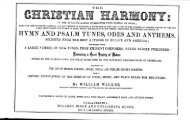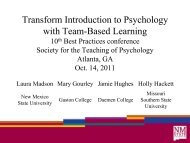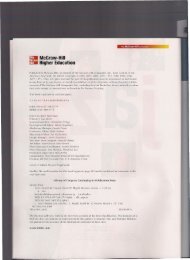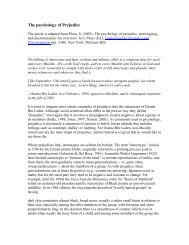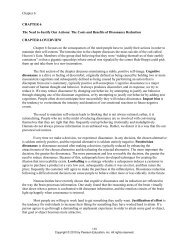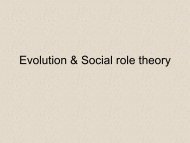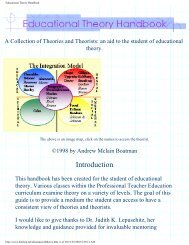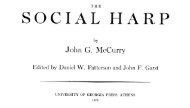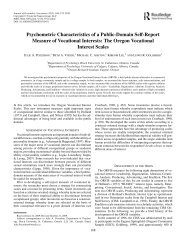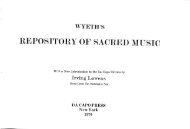Attitudes and Attitude Change CHAPTER 7 Attitudes and Attitude ...
Attitudes and Attitude Change CHAPTER 7 Attitudes and Attitude ...
Attitudes and Attitude Change CHAPTER 7 Attitudes and Attitude ...
Create successful ePaper yourself
Turn your PDF publications into a flip-book with our unique Google optimized e-Paper software.
Essay Review<br />
192<br />
Copyright © 2010 by Pearson Education, inc. All rights reserved.<br />
<strong><strong>Attitude</strong>s</strong> <strong>and</strong> <strong>Attitude</strong> <strong>Change</strong><br />
1. Your essay on attitudes should include:<br />
• <strong><strong>Attitude</strong>s</strong> are evaluations of people, objects, <strong>and</strong> ideas. (p. 178)<br />
• Some attitudes are linked to our genes. Sometimes our attitudes are based primarily on<br />
the relevant facts. To the extent that people's evaluation is based primarily on their beliefs<br />
about the properties of an attitude object, we say it is a cognitively based attitude. An<br />
attitude based more on emotions <strong>and</strong> values than on an object appraisal of pluses <strong>and</strong><br />
minuses is called an affectively based attitude. These can come from classical or operant<br />
conditioning. A behaviorally based attitude stems from people's observations of how they<br />
behave toward an object. (p. 179-181)<br />
• An explicit attitude is one that we consciously endorse <strong>and</strong> can easily report. Implicit<br />
attitudes are involuntary, uncontrollable, <strong>and</strong> at times, unconscious.<br />
(p. 182)<br />
2. Your essay on behaviorally based attitudes should include:<br />
• People infer their attitudes from their behavior when their initial attitude is weak or<br />
ambiguous. (pp. 181-182)<br />
• According to Bem’s self-perception theory, under certain circumstances, people don’t<br />
know how they feel until they see how they behave. People infer their attitudes from their<br />
behavior only when there are no other plausible explanations for their behavior. (pp. 181-<br />
182)<br />
3. Your essay on the Yale <strong>Attitude</strong> <strong>Change</strong> approach should include:<br />
• The three main elements of the Yale <strong>Attitude</strong> <strong>Change</strong> approach are: who (the source of<br />
the communication), what (the nature of the communication), <strong>and</strong> to whom (the nature of<br />
the audience). (p. 184)<br />
• The source is more persuasive if it is credible <strong>and</strong> if the speaker is attractive.<br />
(Figure 7.2, p. 184)<br />
• The message is more persuasive if people do not perceive it as an influence attempt. In<br />
general, two-sided messages are more effective. If two speeches are being given, it is<br />
best to go first if the speeches are given back to back <strong>and</strong> there will be a delay before<br />
people have to make up their minds. If there is a delay between the speeches <strong>and</strong> people<br />
will make up their minds right after hearing the second one, it is best to go last. (Figure<br />
7.2, p. 184)<br />
4. Your essay should include:<br />
• People have to be motivated to take the central route <strong>and</strong> have the ability to pay attention<br />
to the facts. (pp. 185-188)<br />
• One thing that determines whether people are motivated to pay attention to a<br />
communication is the personal relevance of the topic. The more personally relevant an<br />
issue is, the more willing people are to pay attention to the arguments in a speech, <strong>and</strong><br />
therefore the more likely people are to take the central route to persuasion. (pp. 187-189)<br />
5. Your essay on the heuristic-systematic model of persuasion should include:<br />
• The heuristic-systematic model of persuasion is an explanation of the two ways in which<br />
persuasive communication can cause attitude change: either systematically processing the<br />
merits of the arguments or using mental shortcuts (heuristics), such as “Experts are<br />
always right.” (p. 191)





